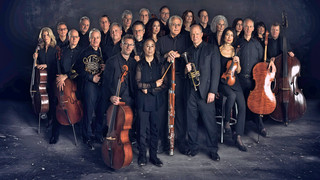|
Back
Back to the Future New York
DiMenna Center for Classical Music
08/13/2022 -
Arnold Schoenberg: Kammersymphonie No. 1, Opus 9
Amy Williams: Telephone
Felipe Lara: Metafagote
Rebekah Heller (Bassoon), Maciej Leandowski (Electronics)
Orpheus Chamber Orchestra

Orpheus Chamber Orchestra (© Orpheus Chamber Orchestra)
“Music is only understood when one goes away singing it and only loved when one falls asleep with it in one's head, and finds it still there on waking up the next morning.”
Arnold Schoenberg
“My music is not lovely.”
Arnold Schoenberg
The Orpheus Chamber Orchestra is 50 years old, and Arnold Schoenberg’s First Chamber Symphony is 116 years old. One of them, as the first Time:Span concert showed last night, showed its age badly.
Certainly nor Orpheus. When they started in 1972 this great ensemble could have resembled that colossal failure of 1920, the conductor-less Soviet Orchestra. If all were comrades, all were equal, said the music-loving Lenin, why how could somebody wave a stick and command them to play?
That became musical anarchy. With the Orpheus Chamber Orchestra, what had commenced as technical symmetry with ventures into individual inspiration evolved to an ensemble of the most extraordinary virtuosity, for which composers wrote, soloist played, and–as shown last night–works which demanded a leader were resurrected into a new enthralling picture.
Arnold Schoenberg, with all the inspiration of his youth, could never have imagined his First Chamber Symphony without a conductor. His later formulaic dodecaphonic works, by definition, played themselves. This piece was so complex that, from its start, needed a leader to coalesce the variegated single instruments.
The Chamber Symphony was described in the program as a “milestone” in musical history. Hardly, though, a destination. The piece shows its age badly. It is grand, complex, it breaks forth in scherzos, interludes, a Debussy-style series of whole-tone scales, mundane themes upon which Schoenberg added variations. The entire ensemble blasts forth in what seems like symphonic songs, only to backtrack into minor motifs. Strings, winds, brass play by themselves, but this is no orchestral concerto.
Most of all, the Chamber Symphony resembles a Richard Strauss tone-poem with the musicians playing wrong notes. Yet, it does have its moments of nobility, many an emotional largesse. It is indeed a milestone, but the roadside sign points in confusing directions, back and forth in time, yearning to be free of 19th Century tonality–heading into the unknown–but at the same time paying homage to the most Germanic early 19th Century composers.
How did Orpheus attack these contradictions? In 2022, they didn’t need to prove its complexity. Rather, they played it with the clarity of a Schubert symphony. The complexity spoke (or misspoke) for itself. Instead, the Orpheus Chamber Orchestra’s splendid soloists showed Schoenberg’s remarkable deftness of orchestral coloring. No, it didn’t have the lyricism of a Richard Strauss, but it did contrast the colors which so many “mathematical” conductors avoid.
The work punctuated those soaring horn solos, those string trios, the percussive accents. One was ready to recognize Schoenberg’s rare themes (after all, he had been a fabulous nightclub-song composer), or to make sense of the structure. But above all, one felt that enormous musical tapestry with figures, icons, symbols wherever you looked.
The texture was glutinous, almost viscous. The Orpheus, though, stressed that color, the accents, the skull and eyes above the organic construction.

A. Williams/F. Lara(© Courtesy of the Artists)
Happily, I did not read the notes for Amy Williams’ Telephone, which opened the program. This was such a joyous orchestral tour de force, I kept thinking of a Jackson Pollock painting. Not the “drip painting” technique. But the result. A series of lines and splotches, colors intercepting each other, areas which dazzled and dazed, where one is swept up rather than (as in the Schoenberg) trying to make sense of the creation.
Later, I discovered my error. That Ms. Williams’ Telephone was about the children’s game of “ passing a simple phrase around a circle of individuals to create inevitable (and fascinating) transformations”. That was her invention, throwing up phrases, having them caught by other instruments, changed, thrown back, retrieved, unalterably altered.
And what fun it was! This was Orpheus at their best, each microscopic phrase, taken together with others, separated, giving resonance and opposition. A terrific piece for any orchestra ready to take on its challenges.
The title of Felipe Lara’s work says it all: Metafagote for Six Pre-Recorded Bassoons and One Solo Electronic Bassoon.
Obviously, anybody allergic to bassoons would have been sneezing and coughing their way out of DiMenna Concert Hall. But bassoon virtuoso Rebekah Heller did such a marvelous job–or marvelous jobs–with the drones, ricochets, knocks, multiphonics from all side of the auditorium–augmented by electronic manipulations of the one live soloist–that one sat back and enjoyed the life of the work.
The Brazilian composer’s Metafagote is hardly the music to play daily to alter our artistic universe. Yet this single hearing by the Ms. Heller was an amiable addition to the Six-Bassoons-Plus-One literature.
Harry Rolnick
|